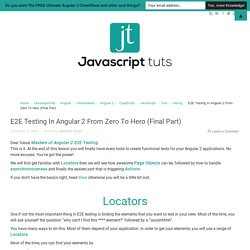

Angular Tutorials: Angular 2 Training. Angular 2 form fundamentals: reactive forms. Angular 2 presents two different methods for creating forms, template-driven (what we were used to in Angular 1.x), or reactive.

We’re going to explore the absolute fundamentals of the reactive Angular 2 forms, covering ngForm, ngModel, ngModelGroup, submit events, validation and error messages. Table of contents High-level terminology Before we begin, let’s clarify what “reactive” forms mean from a high level. Reactive When we talk about “reactive” forms (also known as model-driven), we’ll be avoiding directives such as ngModel, required and friends. Template-driven forms If you’re yet to dive into “template-driven” forms, check out my previous post on it. Form base and interface The base form structure that we’ll be using to implement our reactive form: We have three inputs, the first, the user’s name, followed by a grouped set of inputs that take the user’s email address. Stephen Fluin.
Angular 2 Router: Build a Navigation Menu, Nested Routes, Bootstrap 4. Getting Started with Angular 2 End To End Testing – Medium. Introduction There have been many reasons I have held out on adding automated testing to my applications in the past.

One of them was not knowing the benefit vs cost ratio. Another is the thought that they would be hard to integrate into existing production applications. How do we go about testing our applications without rewriting them from scratch just to introduce testing into them? Let’s start out by briefly identifying the types of tests out there. These two types of tests are usually used in conjunction with each other. Unit tests are still important but I believe if you had to choose one to start with, end to end testing is a better choice. If you need familiarity on getting started with Angular 2, have a look at this other Angular 2 article from Jscrambler. Scenarios to be tested Todo Application Outline Let’s describe our todo application briefly.
On the homepage, we can add new todos. Clone and Setup the Todo Application Make sure you are on the master branch. Npm install ng serve . How to write ATDD tests with cucumber-js, protractor and typescript. ATDD (Acceptance Test Driven Development) has been around for a while now.

I use it quite a lot on projects that I work on. It helps me and others translate requirements into automated tests with the minimum amount of ceremony. We can talk to users about what they want and write that down in a format that they understand and we can automate. One of the ways in which I use ATDD is with AngularJS. There is an end-to-end testing tool for AngularJS called Protractor that supports writing ATDD tests using a testframework called cucumber-js. What is cucumber and why should I care? For those that don’t know cucumber or ATDD for that matter. The idea behind ATDD is that you define acceptance tests in a readable format and automate them using code so that you don’t have to execute them manually everytime you want to validate the functionality of your application.
Using a readable format for your users helps you create a common understanding of what the application does for the user. Getting Started with Angular 2 End To End TestingJscrambler Blog. Angular 2 Router: Build a Navigation Menu, Nested Routes, Bootstrap 4. RXJS. Testing Components in Angular 2 with Jasmine - Semaphore. Dive back into Angular 2 and learn how to test components in a new tutorial in our "Test-driven Development with Angular 2 and Webpack" series.

Introduction In this article, we'll look at how to unit test components built with Angular 2. Components are the centerpiece of Angular 2. They are the nucleus around which the rest of the framework is built. We'll explore what a component is, why it is important, and how to test it. Prerequisites Before starting this article, it is assumed that you: An understanding of Angular 2 is,Knowledge of TypeScript and how it relates to JavaScript,An understanding of ES6/ES2015 concepts such as arrow functions, modules, classes, and block-scoped variables,Comprehension of using command line or terminal such as Git Bash, iTerm, or your operating system's built-in terminal,You have Node >= v4 and NPM >= v3 installed while knowing how to run NPM scripts, andHave a setup capable of unit testing Angular 2 applications. The Sample Project What are Components? The . Building Hacker News with Angular 2 CLI, RxJS and Webpack. If you have ever built an Angular 2 application before, you’ll know that setting up and bootstrapping an application can take a significant amount of time.

Thankfully, the Angular team have rolled out Angular CLI, a command line interface that makes creating and scaffolding an application significantly easier. In this post, we’ll build an entire Hacker News client using Angular CLI, RxJS Observables and Webpack as our module loader. We’ll go through building the entire application step by step. Throughout this post, I’ll try my best to explain my thought process as well as some of the mistakes I’ve made and what I did to fix them. Here’s a rundown of what we’ll be doing. This visual tutorial should make you feel a little more comfortable building an Angular 2 application from small modular parts as well as creating an app from scratch all the way to completion.
The NgModule decorator View Encapsulation RxJS. Testing Components in Angular 2 with Jasmine - Semaphore. E2E Testing In Angular 2 From Zero To Hero (Final Part) - JavaScript Screencasts And Tutorials. Dear future Masters of Angular 2 E2E Testing.

This is it. At the end of this lesson you will finally have every tools to create functional tests for your Angular 2 applications. No more excuses: You’ve got the power! We will first get familiar with Locators then we will see how awesome Page Objects can be, followed by how to handle asynchronousness and finally the easiest part that is triggering Actions. If you don’t have the basics right, head there otherwise you will be a little bit lost.
One if not the most important thing in E2E testing is finding the elements that you want to test in your view. You have many ways to do this. Most of the time, you can find your elements by: Class name.Id.Model.Binding. For the upcoming tests, we will use this template.html: Let’s focus on “nested-class” and “nested-id”. We grab here our element using element(by.css(selector)) then we test if it’s present or not. By Id: By Bindings: Once it reaches your pause, you will have a screen similar to this one: . Three Ways to Test Angular 2 Components – Angular 2. Learning Angular 2: Adding a Master Guild List Component to My Sandbox Application.